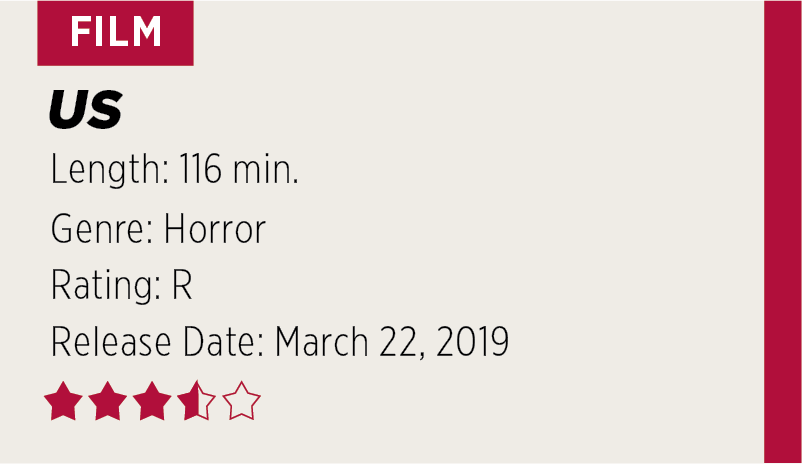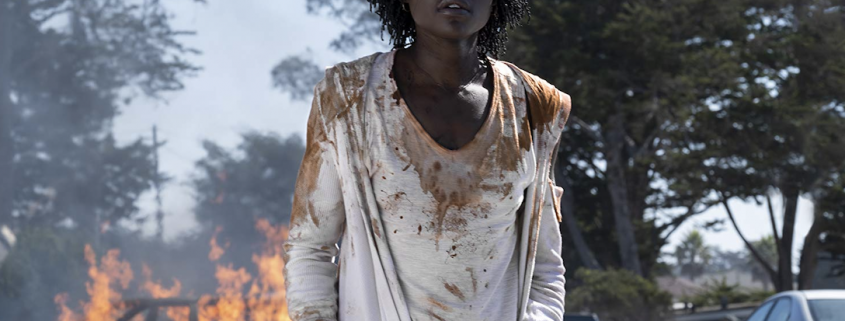REVIEW: Jordan Peele solidifies horror prowess with sophomore feature ‘Us’


“Dull” is not a word in Jordan Peele’s lexicon. The concept of dullness appears to be foreign to him — indeed, his new film “Us” exemplifies this phenomenon.
“Us” hits the ground running and doesn’t stop; even when the film actually does halt to (literally) catch its breath, it rarely disrupts its overall graceful pace. It grabs its audience and never lets go. Even in the post-credits, chances are most people will be trying to solve Peele’s puzzle for days to come.
The bulk of the movie’s magnetism can certainly be attributed to its high-concept premise. A family on a beach vacation encounters another family that appears to be a twisted version of themselves; as the duplicate family sits confronts the real one, one chilling line heightens the tension and sets up the film’s greatest threat: “It’s us.”
The second family are mirror images of the original members with minds of their own — like Peter Pan’s rascal shadow gone berserk on its master.
From the moment the strange family appears in the driveway, “Us” never looks back. Peele mixes horror with psychological thriller, slasher with haunted house. Constant tension and a methodically-revealed plot go hand-in-hand to fashion a gloriously grotesque experience that’s enthralling to watch and consider, especially after its backflip of a conclusion.
Creepy, draped in red jumpsuits and wielding (really, really sharp) scissors, the mysterious duplicates have veiled motivations that go beyond mindless killing. If Peele’s first feature “Get Out” had a problem with clunky exposition in its third act, “Us” is a slightly smoother step forward. Even when characters do take time to explain things to the audience, they don’t do it very straightforwardly — almost nothing in “Us” is spoonfed, which can be a turn-off to many viewers. Part of “Get Out’s” appeal is that it is incredibly smart but still accessible; viewers could revel in proudly saying “I get it.”
That’s not the case at all in “Us.” As the credits roll, it becomes the audience’s job to come up with some answers; the clues are all there, it’s just a matter of paying closer attention next time. It’s a cheeky tactic, but it is impossible to watch “Us” and not mull over it when the credits start rolling.
Even as writer and director, Peele is hardly the film’s only valuable player. None of it would work without two magnetic performances by Lupita Nyong’o. Playing both the real Adelaide Wilson and her doppelganger, Red, Nyong’o elevates every aspect of the film, from its psychological musings to its most terrifying sequences. Her Adelaide is visibly weighed down by anxiety and fear, but Red is so scary precisely because she never shows any inkling of fear — she is unfazed by everything after the horrors she has lived through.
Moments of comedic levity sprinkled throughout are a reminder that Peele, a master of comedy, is behind the curtain pulling all the strings. Comparing this to “Get Out” is inevitable, and probably necessary to see in what direction Peele is headed as a filmmaker. The latter is more subtle about its intentions so it’s a hint more satisfying (and terrifying) when everything wraps up nicely, but the former is arguably more intriguing even as it complicates its deepest truths. Both films will surely remain in the public consciousness through YouTube video essays and endless Reddit threads as subsequent viewings will reveal how dense each is — abounding with set-ups and pay-offs, subtle but poignant social commentary and, as all horror does, revealing that what we fear says a lot more about us than we think.

